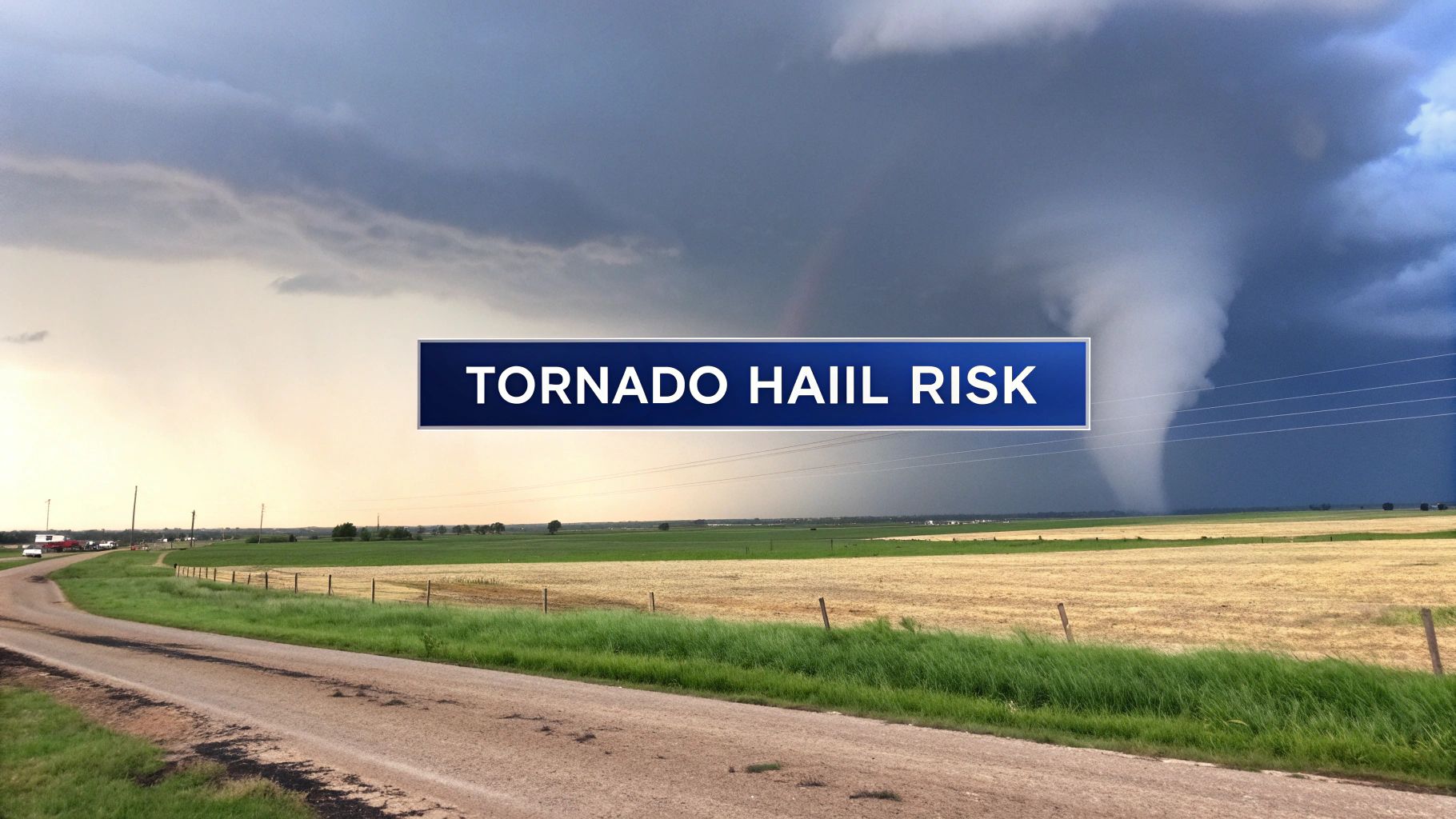For Texas business decision-makers, the simultaneous impact of a tornado and a major hailstorm represents a distinct and severe operational threat. This compound weather event combines the destructive wind forces of a tornado with the piercing, widespread damage of large hail, creating a scenario that can overwhelm standard emergency preparedness protocols and inflict catastrophic financial losses.
The Compound Threat of a Tornado with Hail
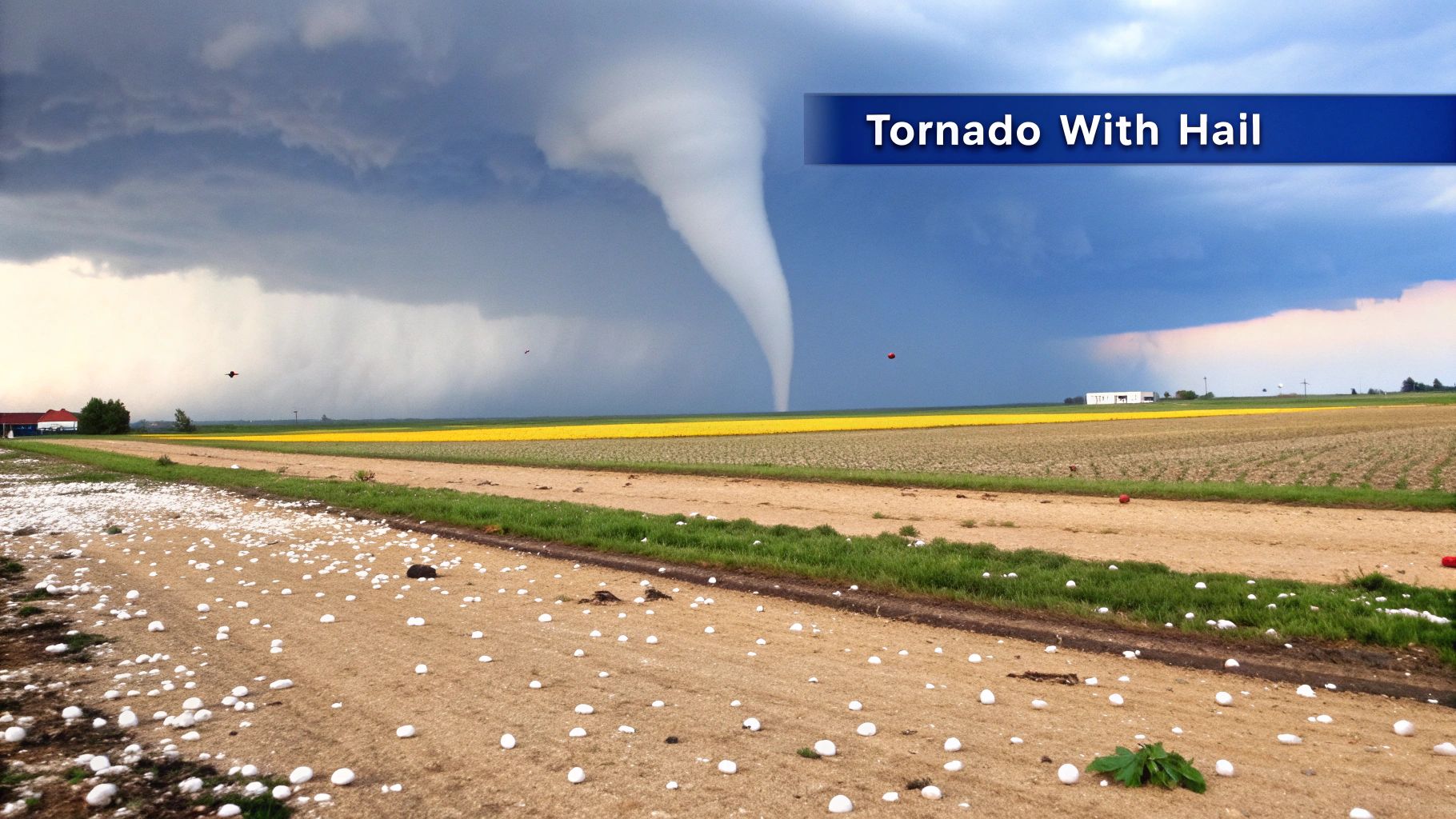
Many Texas businesses have contingency plans for tornadoes, but treating this hazard in isolation is a critical oversight. The powerful supercell thunderstorms that generate tornadoes are frequently the same systems that produce large, damaging hail. This is not two separate weather events; it is a single, integrated assault on facilities, assets, and operational continuity.
The United States experiences more tornadoes than any other country, with a significant number forming alongside severe thunderstorms that also produce hail. This is particularly prevalent in Texas, where the collision of volatile air masses creates ideal conditions for such compound weather phenomena.
A Force Multiplier for Operational Risk
Viewing a tornado solely as a wind event fails to account for the full risk profile. The addition of hail creates a simultaneous attack that multiplies the risk across an entire operation.
Key risk amplifications include:
- Structural Compromise: Large hail can shatter windows, puncture commercial roofing systems, and damage or destroy rooftop HVAC units before the tornado's peak winds arrive. This pre-existing damage compromises the building's structural envelope, making it significantly more vulnerable to catastrophic failure from high winds.
- Asset Destruction: Vehicle fleets, outdoor machinery, and raw material inventories can sustain severe damage from hail. Assets weakened or exposed by hail are then more susceptible to destruction by the tornado.
- Operational Disruption: A hailstorm typically creates a much wider damage swath than the tornado itself. This means critical infrastructure—power lines, communication towers, and transportation routes—can be incapacitated over a larger geographic area, complicating recovery efforts.
This dual threat fundamentally alters the risk calculation for Texas industries. A facility might be engineered to withstand high wind loads, but its resilience is compromised if the roof has already been perforated by grapefruit-sized hail, allowing for massive water intrusion that destroys equipment and inventory.
The table below provides a data-driven breakdown of how the operational risk profile changes when hail is part of the event.
Dual-Threat Risk Profile: Tornado vs. Tornado with Hail
This table compares the operational risks of a standalone tornado versus a combined tornado and hail event, highlighting the amplified dangers for key Texas industries like Manufacturing, Logistics, and Energy.
| Risk Factor | Tornado Only Event | Tornado with Hail Event (Amplified Risk) |
|---|---|---|
| Building Envelope | High wind pressure and debris impact. | Roof and windows weakened by hail first, leading to catastrophic wind failure and widespread water intrusion. |
| Water Intrusion | Primarily from wind-driven rain after structural failure. | Massive, immediate water damage from hail-punctured roofs and shattered windows. |
| Vehicle Fleets | Risk of being overturned or hit by large debris. | Widespread, severe cosmetic and glass damage before the tornado arrives, potentially disabling an entire fleet. |
| Outdoor Inventory | Risk of total loss within the direct tornado path. | Damage across a wider area; products impacted by both ice and wind. |
| Business Downtime | Focused on repairing wind damage and restoring power. | Compounded recovery involving roof, water, and asset damage across a larger operational footprint. |
Understanding this combined hazard is the critical first step toward developing a risk management strategy that can withstand the realities of severe Texas weather. It requires an integrated approach that accounts for both penetrating impacts from hail and extreme wind loads from tornadoes.
For a deeper analysis of frozen precipitation hazards, review our essential guide covering key facts on hailstorms. This guide is for educational purposes only; ClimateRiskNow does not sell insurance or provide financial advice.
The Storm Science Behind This Dual Threat
To effectively manage operational risks, decision-makers must understand the atmospheric mechanics that produce a tornado with hail. These are not coincidental phenomena; they are two hazardous outputs from the same powerful storm system—typically a supercell thunderstorm. A supercell is a highly organized, rotating thunderstorm that functions as an efficient factory for severe weather.
This "factory" is fueled by a volatile combination of warm, moist surface air and cold, dry air aloft. This atmospheric instability creates a powerful updraft, causing air to accelerate vertically. As this air rises, it encounters wind shear—changes in wind speed and direction with altitude. This shear induces rotation in the updraft, forming a structure known as a mesocyclone, the precursor to a tornado.
The Updraft and Hail Connection
Simultaneously, the supercell's powerful updraft serves as a conveyor belt for hail formation. It lifts raindrops into the freezing levels of the atmosphere, where they become ice pellets.
These ice particles are cycled repeatedly within the storm cloud by the violent updraft. Each ascent adds a new layer of supercooled water, causing the hailstones to grow. This process continues until the hailstones become too heavy for the updraft to support, at which point they fall to the ground. The intensity of the updraft is directly correlated with the potential size of the hailstones. According to NOAA, as of mid-2024, the U.S. has already experienced 11 severe weather/hail events that each caused over $1 billion in damages.
The critical takeaway for risk management: the atmospheric conditions that generate strong tornadoes—powerful, rotating updrafts—are the exact same conditions required to produce large, destructive hail. A credible forecast for one implies a high probability of the other.
This infographic illustrates the direct relationship between storm intensity, tornado wind speeds, and potential hail size.
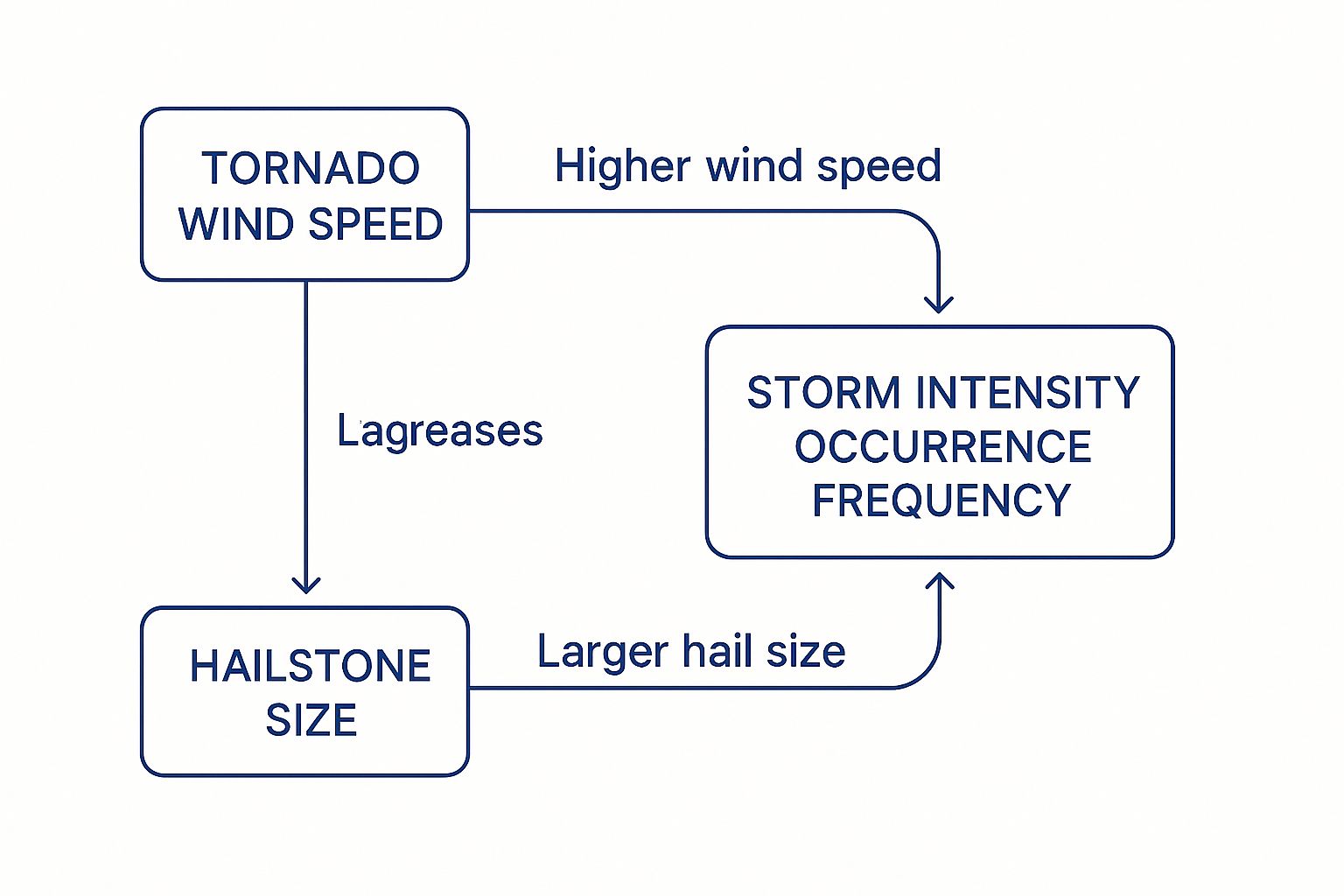
As storm intensity increases, both threats escalate in tandem, making an integrated preparedness strategy essential. Understanding these dynamics allows for more accurate interpretation of meteorological forecasts. Modern forecasting utilizes sophisticated atmospheric simulations; learn more about how meteorologists predict these events in our overview of the weather computer models that inform these alerts. This knowledge is foundational for proactive structural mitigation and robust emergency planning. Please note, the information provided is for educational purposes only; ClimateRiskNow does not sell insurance or provide financial advice.
The Real-World Financial Impact on Texas Industries
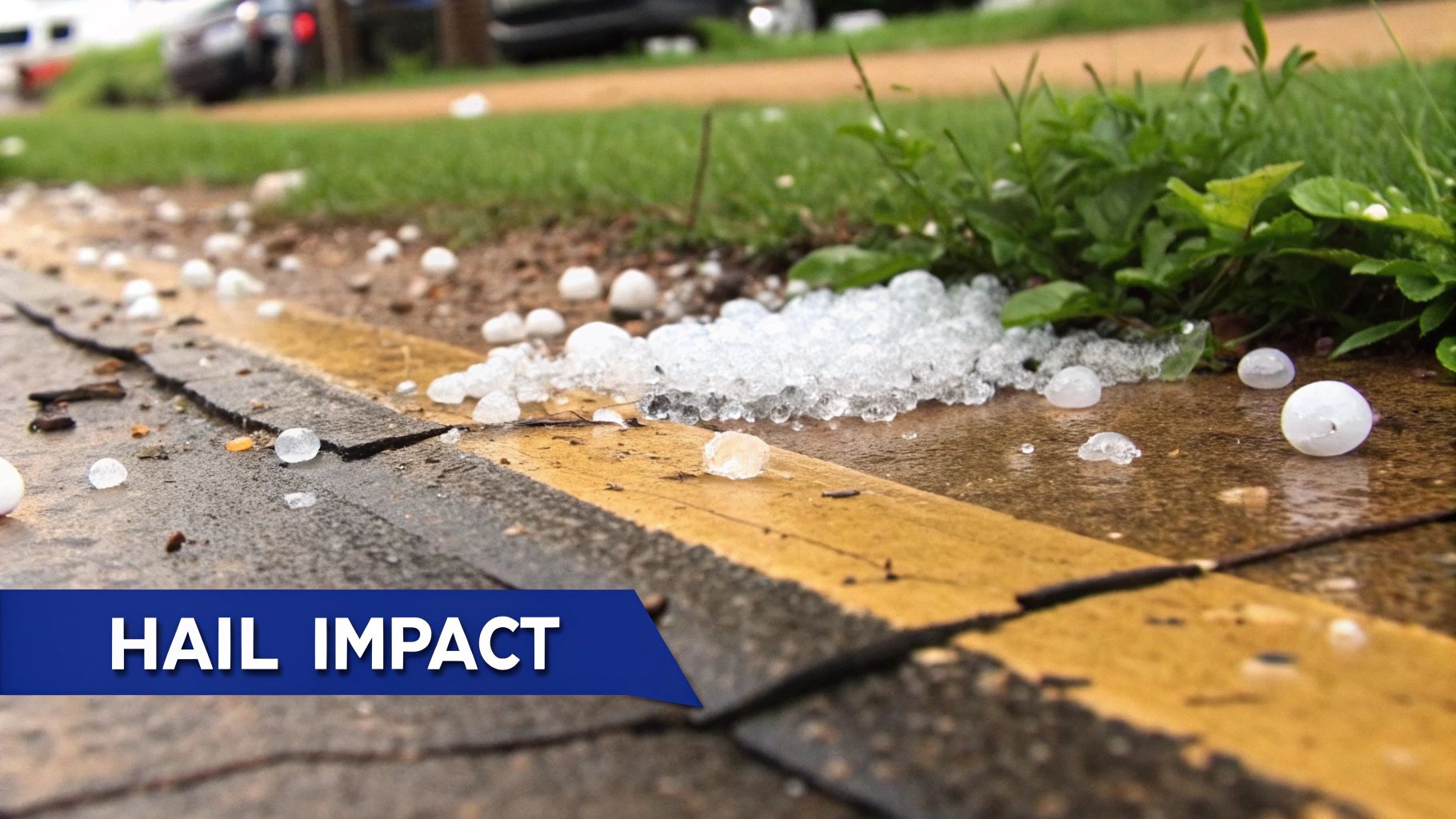
For Texas industries, the atmospheric violence of a tornado with hail translates directly into financial and operational disruption. These are not merely weather events; they are significant balance sheet threats that can cripple production, disrupt supply chains, and inflict long-term economic damage. The impact extends far beyond immediate repair costs, creating a domino effect of lost revenue and market share.
This is a significant national issue. Globally, economic losses from severe thunderstorms—the systems that produce both tornadoes and hail—are rising. Since 1980, these storms have inflicted approximately US$1,000 billion in damages, with a staggering 70% of those losses occurring in the United States.
Sector-Specific Vulnerabilities
A tornado combined with large hail creates a unique damage profile for each of Texas’s key sectors, demanding tailored risk assessment and mitigation strategies.
For the Energy & Petrochemical sector, the primary risks involve exposed infrastructure. Hail can dent pipelines and damage the cooling fins on critical heat exchangers. Once weakened, these structures are highly susceptible to tornadic winds, which can lead to structural failure, hazardous material spills, and operational shutdowns that impact the national energy supply. Regulations from agencies like the Texas Commission on Environmental Quality (TCEQ) and the EPA require stringent containment and emergency response plans for such events.
In Manufacturing, the building envelope is the first line of defense. Commercial flat roofs are easily punctured by large hailstones, leading to immediate and massive water intrusion. The resulting damage can destroy high-value machinery, contaminate inventory, and compromise entire electrical systems. Financial losses include not only asset replacement costs but also penalties for unfulfilled orders and erosion of market share.
Quantifying the Operational Downtime
While physical damage is visible, the most significant financial impact often comes from operational downtime. A tornado with hail disrupts business continuity.
The true cost of a dual-threat storm is measured in hours of lost production, delayed shipments, and broken contracts. Proactive mitigation is not an expense—it is a strategic defense of your company’s ability to operate and generate revenue.
Consider these industry-specific scenarios:
- Logistics: A single hailstorm can sideline an entire fleet of trucks by shattering windshields and damaging cargo, causing immediate supply chain gridlock.
- Construction: An active job site is highly vulnerable. Unsecured materials and partially completed structures can be destroyed in minutes, causing significant project delays and invoking contractual penalties.
- Agriculture: For agricultural operations, timing is critical. Hail can destroy an entire field of high-value crops just before harvest, while tornadic winds can demolish barns and silos, resulting in a total loss for the season.
When assessing financial fallout, it's crucial to understand the complexities of business interruption. Water intrusion is one of the most common and costly consequences. Understanding insurance coverage for water damage questions and effectively navigating insurance and natural disasters before a storm is a critical component of risk management.
Disclaimer: ClimateRiskNow does not sell insurance or financial products. The information provided is for educational purposes only and should not be considered financial advice.
Historical data from past disasters provides critical, actionable insights that forecasting models alone cannot. Analyzing major Texas storms reveals the practical realities of a tornado with hail, offering a clear blueprint of effective and ineffective preparedness strategies.
A relevant case study is the May 1995 storm that struck Fort Worth. A massive supercell produced a tornado alongside softball-sized hail. For logistics and manufacturing firms, the sequence was catastrophic. First, the large hailstones punctured commercial roofs and shattered skylights. Seconds later, tornadic winds exploited these newly created vulnerabilities, peeling back damaged roofing material and allowing torrential rain to inundate facilities. Millions of dollars in equipment and inventory were destroyed within minutes.
The True Cost of Compounded Damage
This event illustrates a critical lesson: the damage is not merely additive; it is exponential. The hail created the conditions for catastrophic failure when the high winds arrived. This pattern is recurrent in severe Texas weather events.
The financial cost of this pattern is significant. Nationwide, from 1980 to 2022, severe storms—including compound tornado and hail events—accounted for 163 separate billion-dollar disaster events, more than any other weather category. According to NOAA's analysis of 2022's billion-dollar weather and climate disasters, these storms caused $383.7 billion in cumulative damages, averaging $2.4 billion per event.
Another powerful case study is the 2011 storm outbreak that impacted agricultural operations across East Texas. Hail shredded acres of crops, causing a total loss for many farmers. Subsequent tornadoes destroyed barns, irrigation systems, and processing facilities. This event exposed a significant supply chain vulnerability. The scale of the storm crippled regional processing and distribution, affecting businesses that were not in the storm's direct path.
Lessons Learned: A business is exposed not only to the storm that impacts its own facility but also to the one that hits its suppliers, distributors, and the infrastructure connecting them. Resilient business continuity planning must extend beyond the fenceline to include the entire supply chain.
These historical events underscore a vital truth: preparing for a tornado or a hailstorm as separate, independent events is insufficient in Texas. Strategic planning must account for a coordinated weather assault where one threat systematically weakens defenses just before the other strikes.
Disclaimer: ClimateRiskNow does not sell insurance or financial products. The information provided is for educational purposes only and should not be considered financial advice.
Putting a Plan in Place to Mitigate Your Risk
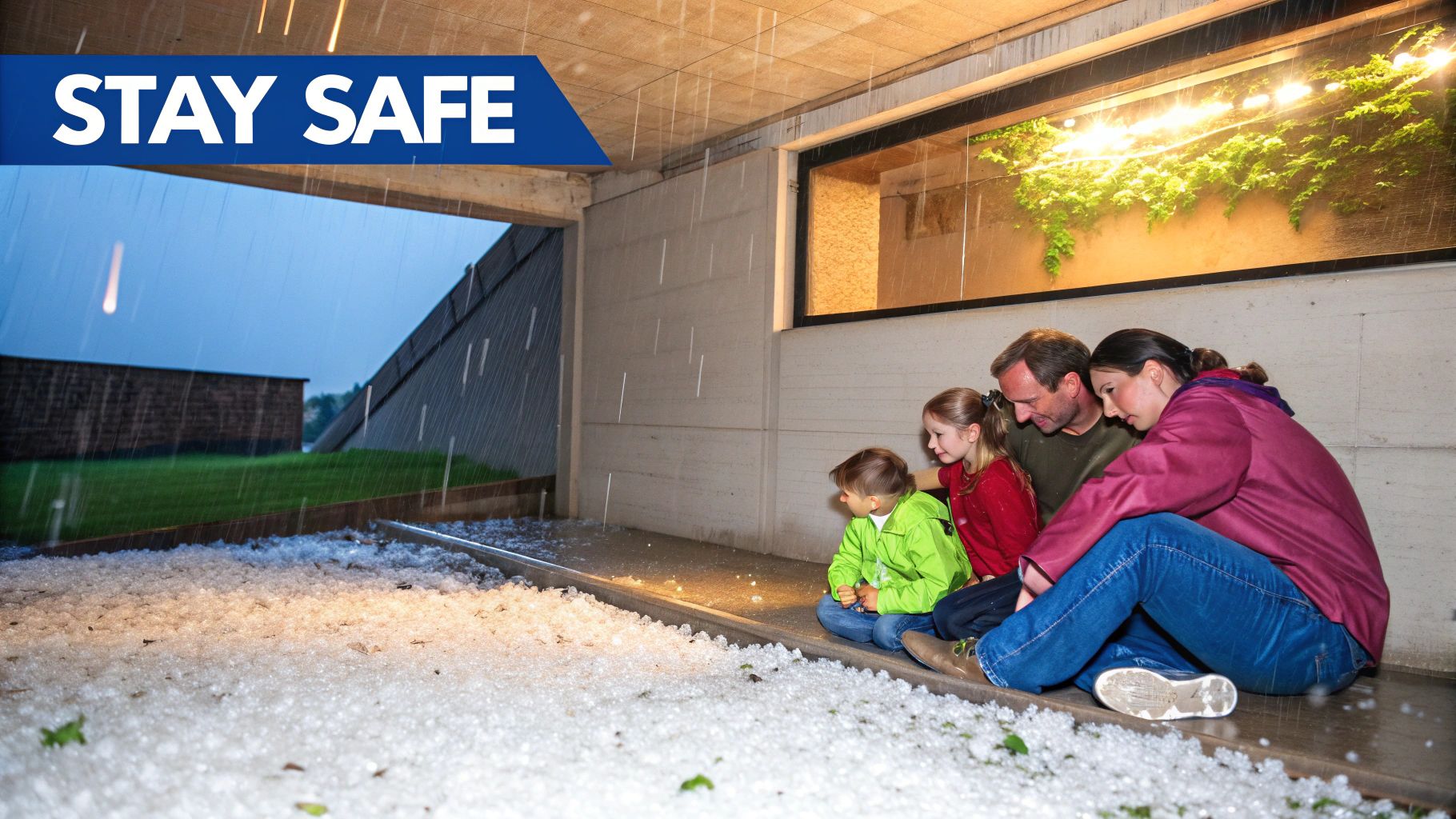
Acknowledging the compounded threat of a tornado with hail is the first step; taking decisive action to protect operations is the necessary follow-through. The objective is to transition from a reactive posture to a state of proactive preparedness. This requires a deliberate, multi-layered strategy that hardens facilities, refines operational response, and reinforces the supply chain. This approach aims to minimize damage and accelerate recovery, providing a competitive advantage over less-prepared entities.
Fortifying Your Physical Assets
The primary line of defense is the structural integrity of the building and the protection of critical assets. As hail often precedes tornadic winds, hardening facilities against impact damage is critical.
- Impact-Resistant Roofing: For manufacturing and logistics facilities, a punctured roof leads to immediate and catastrophic water damage. Upgrading to Class 4 impact-resistant roofing materials can be the difference between a minor repair and a total loss of inventory and machinery.
- HVAC Protection: Rooftop HVAC units are highly vulnerable and essential for many operations. Installing engineered hail guards or reinforced cages is a cost-effective measure to shield these critical systems from impact damage.
- Securing Outdoor Assets: On construction sites and in agricultural operations, unsecured vehicles, equipment, and materials become dangerous projectiles in tornadic winds. Establish clear protocols for moving mobile assets to shelter and securing all other materials when a severe storm is forecast.
A fortified structure is a primary defense, but it’s only half the battle. Your operational response plan determines how effectively your team can act under pressure to protect people and minimize downtime when a tornado with hail is imminent.
Streamlining Operational Preparedness
A robust operational plan translates warning time into effective preparation. It requires pre-defined protocols that eliminate ambiguity and ensure a swift, coordinated response. This extends beyond basic shelter-in-place drills to include detailed shutdown sequences for complex machinery, redundant emergency communication systems, and data backup procedures to ensure business-critical information remains secure and accessible. For a deeper look at sector-specific planning, our guide to Tornado Alley manufacturing preparedness provides actionable checklists.
Building Supply Chain Resilience
A dual-threat storm can sever operational lifelines even if a facility escapes direct impact. The failure of a key supplier or the blockage of a major transportation route can halt business operations as effectively as a direct hit.
Key Supply Chain Actions:
- Map Your Dependencies: Identify all single-source suppliers and critical logistics hubs located in high-risk weather zones to understand your vulnerabilities.
- Qualify Alternate Partners: Pre-vet secondary suppliers and transportation carriers outside of your primary operational region to enable rapid logistical pivots.
- Increase Critical Inventory: For essential components with long lead times, maintain strategic safety stock to buffer operations against short-term supply chain disruptions.
By focusing on these three pillars—structural hardening, operational planning, and supply chain resilience—a business can build a defense-in-depth strategy that addresses the full spectrum of risks from a tornado with hail.
Disclaimer: ClimateRiskNow does not sell insurance or financial products. The information provided is for educational purposes only and should not be considered financial advice.
Crafting Your Business Recovery Blueprint
Surviving the storm is the immediate challenge; resuming operations efficiently is the long-term goal. An effective business continuity plan outlines the steps to take after a tornado and hail event, transforming a potential crisis into a manageable setback. This is not a static document but an actionable blueprint for a rapid, organized recovery.
A critical first step is establishing a clear chain of command for disaster scenarios. When primary communication and power systems fail, the team must know who has decision-making authority to minimize chaos and enable decisive action.
Key Components of a Recovery Plan
A comprehensive recovery plan is built on several critical pillars designed to address immediate safety and long-term operational stability.
- Employee Communication Protocols: Establish a reliable system, such as a dedicated emergency notification service or a call tree, to confirm employee safety and disseminate critical updates. Clear, consistent communication reduces anxiety and coordinates recovery efforts.
- Pre-Arranged Vendor Agreements: Secure retainer agreements with critical recovery vendors—such as commercial roofing contractors, restoration companies, and IT specialists—before a disaster occurs. This ensures priority service when demand is highest.
- Financial Contingency Planning: A major storm can halt revenue streams. A key part of recovery is a financial contingency plan for addressing cash flow problems to cover immediate expenses and fund rebuilding efforts.
A recovery plan is only as effective as its most recent test. Conducting regular drills and tabletop exercises is the only way to identify weaknesses in your strategy and ensure your team can execute the plan under pressure.
Ultimately, a well-rehearsed plan creates a structured, step-by-step response in a chaotic aftermath. Our disaster recovery planning template offers a framework for building a customized blueprint to get your business back online safely and efficiently.
Disclaimer: ClimateRiskNow does not sell insurance or financial products. The information provided is for educational purposes only and should not be considered financial advice.
Your Questions Answered
For business leaders in Texas, preparing for a complex threat like a tornado with hail raises specific, practical questions. The following are common inquiries from our clients during risk assessment and planning.
How Can My Business Get Reliable Early Warnings?
A multi-layered warning system is best practice. Combine a commercial-grade weather service that provides location-specific alerts on rotation and hail size with a dedicated NOAA Weather Radio for official government warnings. Designate and train specific team members to monitor these systems during high-risk periods and establish clear triggers for activating your emergency protocols.
What Are the Most Critical Physical Assets to Protect?
Prioritize assets that are essential to your core business operations. For most industrial facilities, this includes rooftop HVAC units, electrical transformers, and outdoor storage tanks. In logistics, the vehicle fleet is paramount. In agriculture, livestock and high-value equipment are key. Protection strategies range from structural hardening, such as installing hail guards and reinforced shelters, to implementing rapid-response plans for moving mobile assets to safety.
Beyond direct physical damage, a prolonged supply chain disruption is a significant threat that often blindsides companies. Your facility may escape the worst of a storm, but if regional infrastructure or key suppliers are impacted, your operations could be offline for weeks.
What Is the Biggest Hidden Operational Risk?
The most significant and often overlooked operational risk is the ripple effect on your supply chain. A robust business continuity plan must extend beyond your own facility to include the identification and qualification of alternate suppliers and logistics routes before a disruption occurs. This secondary impact can cause longer and more costly business interruptions than the initial physical damage from the storm itself.
Disclaimer: ClimateRiskNow does not sell insurance or financial products. The information provided is for educational purposes only and should not be considered financial advice.
Stop reacting to weather and start planning for it. ClimateRiskNow transforms complex climate data into a clear strategic advantage, providing location-specific risk assessments that empower Texas businesses to safeguard assets and ensure operational continuity.
Get the actionable intelligence you need to make informed decisions. Request your custom assessment at https://www.climaterisknow.com.

